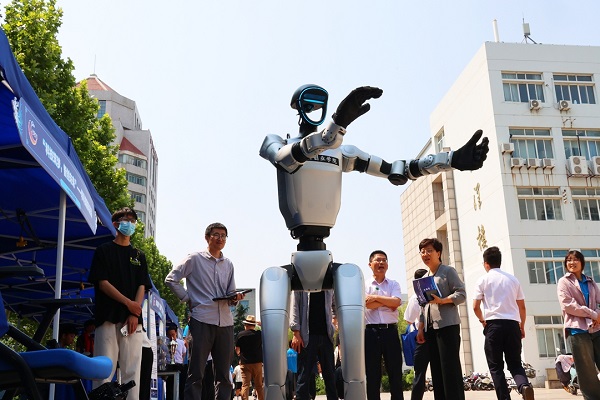Robot dancing and fighting aim to showcase real tech progress: Unitree Robotics founder

A humanoid robot performs at a carnival held at Jiangsu Ocean University in Lianyungang, East China's Jiangsu province on May 28. Photo: VCG
Unitree Robotics founder and CEO Wang Xingxing on Friday discussed the use of humanoid robots in dancing and fighting competitions, saying such performances are crucial for developing their full-body movement capabilities as the company works toward deploying them for labor-intensive tasks, Jiemian.com reported on Friday.
"Our ultimate goal is to have AI-powered robots take on arduous work for humans, but before that's achievable, participating in performances allows us to showcase real technological progress and generate some commercial value," Wang said at the Beijing Academy of Artificial Intelligence (BAAI) Conference, which was held in Beijing on Friday.
The comments come amid skepticism over whether flashy demonstrations of humanoid robots dancing or fighting are relevant for real-world challenges like functional adaptability and commercial applications, according to Jiemian.com.
The company's robots performed at this year's Spring Festival Gala, and their smooth movements drew enthusiastic reactions.
At the world's first humanoid robot boxing match, which kicked off in Hangzhou, East China's Zhejiang Province on May 25, contestants from companies including Unitree Robotics went through multiple rounds of combat, displaying their prowess.
Wang said that the rental market for humanoid robots has been booming in the first half of this year, adding that the competitions themselves have already brought some industrial value. He also believes that robot fighting will become a popular sporting event in the next few years.
China's humanoid robot industry, as one of the representative fields for new quality productive forces, is seeing a period of upward growth.
Since the beginning of 2025, China has witnessed remarkable acceleration in the development of humanoid robots. Companies are driving continuous technological innovation, enhancing the robots' mobility, intelligence, and interactive capabilities, which lays a solid foundation for more widespread adoption, Wang Peng, an associate research fellow at the Beijing Academy of Social Sciences, told the Global Times on Friday.
Humanoid robots are also demonstrating their economic significance. The R&D, production, and sales of humanoid robots directly stimulate growth in related industries, creating new economic growth engines. Also, their applications across various sectors - such as industrial manufacturing, logistics, healthcare, and services - boost productivity, reduce costs, improve service quality, and facilitate the transformation and upgrading of traditional industries, injecting fresh impetus into economic development, Wang said.
The 2025 Humanoid Robotics and Embodied Intelligence Industry Research Report shows that in 2025, China's embodied intelligence market is expected to reach 5.295 billion yuan ($736.92 million), accounting for approximately 27 percent of the global market; and the humanoid robotics market is projected to reach 8.239 billion yuan, representing about 50 percent of the global total, according to China News Service.
The rapid development of the embodied intelligence sector has generated investment momentum. Data from Shanghai Xiniu Information Technology Co shows that as of May 30, there have been over 300 global robot-related investment events in 2025, with a total financing scale exceeding 20 billion yuan. Investment activity in China's robotics industry accounts for over 82 percent of the global total, the Securities Times reported.
According to data from Tianyancha, as of Thursday, there are more than 900,000 robotics-related enterprises in China. Among them, 100,000 were established in the first five months of this year, a 44 percent increase compared to the same period in 2024.
-
Visionary Pathway - Hangzhou Playbook
July 15, 2025



